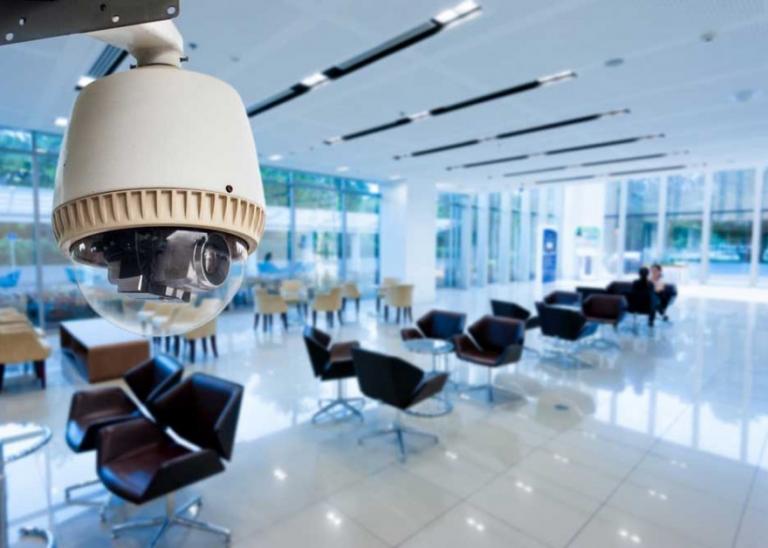Camera Basics Series: PTZ Camera Basics
By ECAMSECURE 09/03/2021

PTZ Camera Basics
Pan-tilt-zoom or PTZ cameras have been around for years and had become a popular camera for a range of applications.
Pan-tilt-zoom or PTZ cameras can be used to provide surveillance over much larger areas than conventional security cameras. Modern PTZ cameras consist of compact, all- in- one package that contains super high resolution cameras that are outfitted with powerful motorized zoom lenses.
The motors can adjust the camera’s aim and zoom, as well as tilted to 180 degrees and reposition to 360 degrees in the blink of an eye to capture minute details in a vies, including a face and license plate numbers.
You can find PTZ cameras in a variety of commercial, institutional, industrial , and residential locations, whether it’s a retail storefront, parking garage, religious facility, sporting venue, apartment building or construction site construction security. As video security continues to become more common, many business owners, decision-makers and property owners have discovered how various types of PTZs can provide additional layers of security and other applications.
Features Pan-Tilt-Zoom Cameras
In the past, only the entities that possessed the resources to hire personnel to continuously watch and control PTZs and similar products would deploy these cameras. For example, casinos typically have multiple operators who monitor patrons as they come, go and move about, table game action, slot machines, cage transactions, point-of-sale dealings food and beverage locations, and workers in offices will and throughout the house.
Although PTZ cameras that are on the market today can be programmed and no longer requires manual operation, casino owners and other organization continue to rely on this method of surveillance.
Here are some of the primary characteristics of PTZs:
- User controlled – Manual control by the user via a desktop joystick.
- Software controlled – Software gives you the capability for the individual setup and control and view of your PTZ cameras from your laptop, iPad/iPhone, Android device, or other smartphone
- Remote controlled – the cameras can be operated from remote locations over the Internet or smart phone from the remote access feature of the DVR.
- Automatic tours – Programmable presets allow cameras to automatically conduct surveillance—panning, tilting and zooming to pre-determine viewing locations for a preset period before moving to the next preset view.
- Low Light – The low light feature provides exceptionally clear pictures in almost no light. The low light level can be adjusted as low as .002 LUX.
- Night Vision – For duration’s where there is no light, you can purchase a long range night vision people PTZ cameras that have an infrared light that allows them to produce clear black and white video in total darkness.
This powerful amalgam of features enables PTZ cameras to cover the surveillance area typically required by four traditional security style cameras.
You can choose from several types of pan-tilt-zoom cameras depending on your particular need and application. Nonetheless, they all have the same basic features—optical zoom lens that can be controlled from remote locations, the ability to tilt the camera 180 degrees and pan 360 degrees.
PTZs come in indoor and outdoor casings and can stand up to rain, wind and now. Even extreme heat won’t affect performance.
PTZ Camera Installation
Cameras can be mounted on the wall or ceiling, flush or on the surface. You will need to consider three components of a PTZ camera installation before you can start the process. All three aspects require power, a video cable connection from the camera to the DVR and a communication-data cable.
1. Power – Pan-Tilt-Zoom have multiple motors built into the housing, which requires much more power than a traditional surveillance camera. The power source can be at the camera location or you can pull power to the camera. The gauge of the wire determines the maximum distance the cable can run from the camera to the power source.
The following chart list the maximum distance and appropriate wire size:
- Maximum Distance 320 Feet – 12 Gauge Wire
- Maximum Distance 225 Feet – 14 Gauge Wire
- Maximum Distance 150 Feet – 16 Gauge Wire
- Maximum Distance 100 Feet – 18 Gauge Wire
PTZ cameras can operate on 12v DC or 24v AC. Each camera is usually shipped with its own power supply. Prior to installation, make sure that the power supply type matches the specific camera.
You have two options when it comes to providing power to PTZ cameras: 1) use the power supply that comes with the camera or 2) use a multi-camera power supply that can supply multiple cameras from a central location. These multi-camera supply packs are available in both 12v DC and 24v AC versions.
2. Video – The camera transmit the video signal back to the DVR using a RG59 (maximum distance 500 feet) or RG6 (maximum distance 1,000 feet) video coax cable. You can also use Cat5 network cable and video Baluns long run or convenience,
3. Communication – Most installers use a CAT5 network cable or other two-wire communication-data cable to control PTZs. This cable connects to the data port on a PTZ Joystick control or to the DVR’s RS485 data ports. For dual control- using both the DVR software and the joystick controller at the same time, you will need to extend a data cable from the DVR’s data port to the data port located on the Joystick control and on to the first PTZ camera.
Next, run a “Daisy Chain Configuration.” This simply means extending data cable from that camera directly to the second camera, from the second camera directly to the third camera, and so on. Since each camera has a specific address, this allows the joystick or DVR to communicate with several PTZs connected on a single data cable run.
Other wiring options include the “Star Configuration,” which requires you to run a data cable from the DVR or Joystick to each camera or you can employ a combination of Daisy Chain and Star configuration wiring. The total run or length of communication-data cable extended to all PTZ cameras should not exceed 4,000 feet.
Options for Communication-Data Cable
RG59 Siamese cable
To make the installation easier, consider using RG59 Siamese coaxial cable, which is sometimes called Siamese cable. This heavy-duty wire consists of a RG 59 cable combined with a pair of 18 gauge 2 conductor wires, which allows you to run the power and video for your PTZ cameras simultaneously and over long distances without interference. Siamese cable cuts your installation time by 50 percent.
CAT5 & Video Baluns for Long Runs
A viable alternative to using RG59 Siamese cable would be to pull CAT5 network cable to the PTZ and use a pair of our Video-Baluns to transmit the video signal back to the DVR. The beauty of the Video Balun approach is its ability to change the video signal to send a higher quality transmission up to 3,000 feet employing just two conductors in the CAT5 cable. Note that the type of Video Balun determines the maximum distance. Use one of the pairs of wires in the CAT5 network cable to send the communication-data back to the DVR.
Twisted Two-Conductors & Phone Cable
You can also use twisted two conductor shielded cable as the communication-data cable—run the cable independently from one PTZ camera to the next. When telephone communication cable connects one building to another, consider using one pair as the communication-data cable and another pair to send video signal along with a pair of Video Baluns.
Termination & Addressing
Follow the documentation included with your PTZ camera for detailed wiring connections and set up. The wire termination includes the following:
- Two AC or DC power terminals for supplying power the camera.
- One female BNC connection for the video.
- Two terminals—(+) Red, (-) Black—for communication data
Remember, each PTZ camera has a unique assigned address or ID which allows you to identify and control each camera independently by the desktop or Joystick. Simple set the dip switches, represented by binary values of either On (1) or Off (0), which are located inside or on the camera to the chosen address. Y
Once you complete the setup, you will be able to position the cameras, configure preset positions and use more advance controls after you enter certain information into the DVR and depending on its capabilities.
Conclusion
Similar to any investment, you will need to complete your due diligence in order to make a sound decision about PTZ cameras and other aspects of your IP surveillance needs. This includes, but is not limited to, answering the following questions:
- What features are the most important?
- What other devices I will need to invest in to deploy the system?
- Do I have adequate storage on my hard drive?
- Will I need more bandwidth for my security system to operate effectively?
- How much will it cost?
With so many different cameras, lenses, Video Management Software ( alarms, motion detection,controls video display, video recording, and retrieval), enclosures, and other components on the market it can become overwhelming. Contact camera surveillance, security, networking expert for assistance to ensure that you make the right choice and get everything you need to adequately secure your business and employees at the best price.


